Home | Audio | DIY | Guitar | iPods | Music | Brain/Problem Solving | Links| Site Map
This work is licensed under a Creative Commons License.
An Introduction to DVD Recordable (DVD-R)
What is DVD Recordable?
Overview
DVD Recordable (DVD-R) technology allows anyone to create DVD discs at the desktop. Similar in concept to Compact Disc Recordable (CD-R), DVD-R is a write-once medium that can contain any type of information normally stored on mass produced DVD discs – video, audio, images, data files, multimedia programs, and so on. Depending on the type of information recorded, DVD-R discs are usable on virtually any compatible DVD playback device, including DVD-ROM drives and DVD Video players.
A DVD-R disc is able to contain a maximum of either 4.7 or 3.95 billion bytes of information on each side, depending on the type of blank media used. Since the DVD format supports double-sided media, up to 9.4 Gbytes can be stored on a single double-sided DVD-R disc.
Data can be written to a disc at a DVD "1X" equivalent of 11.08 megabits per second (Mbps), which is roughly equivalent to nine times the transfer rate of CD-ROM’s "1X" speed. After recording, DVD-R discs can be read at the same rate as mass produced replicated discs, depending on the "X" factor of the DVD-ROM drive used. These transfer rates, coupled with DVD-R’s capacity and conformance to worldwide DVD standards, makes it an extremely viable and cost effective storage medium.
DVD-R Technology
DVD-R is a write-once format, meaning that data can be written to a disc and stored without fear of accidental erasure. The fundamental technology employed is similar to that used by CD-R, except that data is written at a higher rate and density. DVD-R, like CD-R, uses a constant linear velocity rotation technique to maximize the storage density on the disc surface. This results in a variable number of revolutions per minute (RPM) as disc writing/reading progresses from one end to the other. Recording begins at the inner radius and ends at the outer. At "1X" speeds, rotation of the disc varies from 1,623 to 632 RPM on 3.95 Gbyte media and 1,475 to 575 RPM on 4.7 Gbyte media, depending on the record/playback head’s position over the surface. On 3.95 Gbyte media, the track pitch, or the distance from the center of one part of the spiral information "track" to an adjacent part of the track, is 0.8 microns, one-half that of CD-R. 4.7 Gbyte media uses an even smaller track pitch of 0.74 microns.
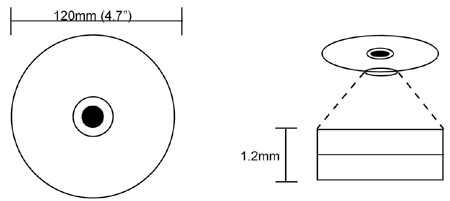
DVD-Recordable Disc Dimensions
To help achieve a six to seven-fold increase in storage density over CD-R, two key components of the writing hardware needed to be altered: the wavelength of the recording laser and the numerical aperture (n.a.) of the lens that focuses it. With CD-R, an infrared laser with a wavelength of 780 nanometers (nm) is employed, while DVD-R uses a red laser with a wavelength of 635 nm. At the same time, the numerical aperture of a typical CD-R drive’s objective lens is 0.5, while a DVD-R drive uses lenses with an n.a. of 0.6. These factors allow DVD-R discs to record marks as small as 0.40 µm as compared with the minimum 0.834µm size with CD-R. The table below highlights the differences between some basic parameters of both media formats:
| Parameter | DVD-R | CD-R |
| Media Type | Write-once | Write-once |
| Wavelength (Recording) | 635 - 645 nm | 775 - 795 nm |
| Wavelength (Reading) | 635 - 650 nm | 770 - 830 nm |
| Recording Power | 6 - 12 mw | 4 - 8 mw |
| Numerical Aperture (Recording) | 0.60 | 0.50 |
| Numerical Aperture (Reading) | 0.60 | 0.45 |
| Reflectivity | R14H > 0.6 | RTOP > 0.65 |
Recording on DVD-R discs is accomplished through the use of a dye recording layer that is permanently transformed by a highly focused red laser beam. This dye substance is spin-coated onto a clear polycarbonate substrate that forms one side of the "body" of a complete disc. The substrate is injection molded, and has a microscopic, "pre-grooved" spiral track formed onto its surface. This groove is used by a DVD-R drive to guide the recording laser beam during the writing process, and also contains recorded information after writing is completed. An undulating "wobble" signal is molded into the pre-groove for synchronizing a DVD-R drive’s spindle motor during the writing process, and "Land Pre-Pits" (LPP) are also contained in the land areas between grooves for addressing purposes. A thin layer of metal is then sputtered onto the recording layer so that a reading laser can be reflected off the disc during playback. A protective layer is then applied to the metal surface, which prepares the side for the bonding process.
These steps are done for each side of a disc that will be used for recording. If only a single recording side is required, then the opposite side can contain a label or some other visible information such as pit art. If both sides are needed for recording, then two recordable sides can be bonded together as depicted in the diagram below. In this case each side must be read directly by flipping the disc over, as dual layer technology is not currently supported.
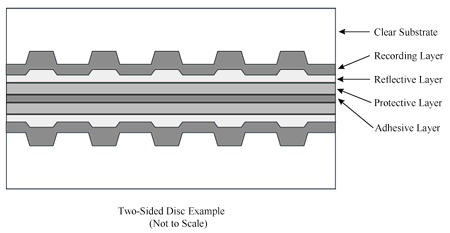
The recording action takes place by momentarily exposing the recording layer to a high power (approximately 8-10 milliwatt) laser beam that is tightly focused onto its surface. As the dye layer is heated, it is permanently altered such that microscopic marks are formed in the pre-groove. These recorded marks differ in length depending on how long the write laser is turned on and off, which is how information is stored on the disc. The light sensitivity of the recording layer has been tuned to an appropriate wavelength of light so that exposure to ambient light or playback lasers will not damage a recording.
Playback occurs by focusing a lower power laser of the same approximate wavelength (635 or 650 nm) onto the surface of the disc. The "land" areas between marks are reflective, meaning that most of the light is returned to the player’s optical head. Conversely, recorded marks are not very reflective, meaning that very little of the light is returned. This "on-off" pattern is thereby interpreted as the modulated signal, which is then decoded into the original user data by the playback device.
Expected Life of DVD-R Media
Life expectancy is a key issue when considering the use of DVD-R for applications such as document imaging and other archival applications. Although each disc media manufacturer has its own life expectancy rating, Pioneer DVD-R media is currently rated at better than 100 years.
Compatibility
Properly recorded DVD-R discs should be playable on nearly any destination device that can properly make use of whatever data is written. The diagram below illustrates this:
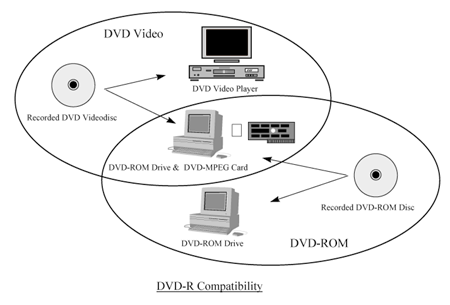
Recorded DVD Video discs can be played on a DVD video player, as well as a computer that is equipped with a DVD-ROM drive, a DVD-compliant MPEG decoder card (or decoder software) and application software that emulates a video player’s control functions. A recorded DVD-ROM disc can be read by a computer equipped with a DVD-ROM drive, as well as a computer equipped for DVD video playback as described above. DVD Video components are not necessary, however, if DVD Video material is not accessed or is not present on a disc.
Recorded DVD-R discs support a new file system called "UDF Bridge". This is a hybrid approach that provides both the newer UDF (Universal Disc Format) system as well as the older ISO-9660 system used by the CD-ROM format. This allows DVD discs to be used with computer operating systems that do not have any provision for UDF support.
Recording a Disc
The basic recording process for DVD-R discs should be familiar to any user of CD-R technology. Like CD-R, blank DVD-R discs are recorded in a DVD-R drive that is controlled by a host computer. The recording process is orchestrated by application software that allows a user to specify which files will be transferred to the disc as well as conducting the actual recording itself.
All DVD discs, recordable or not, must have three basic areas recorded on them: lead-in, user data and lead-out. The lead-in and lead-out areas are boundaries that indicate to a playback device where the inner and outer limits of a recording are respectively. They contain no user accessible information, but are critical to the proper functioning of a disc.
There are two methods of writing a DVD-R disc: disc-at-once and incremental writing. Disc-at-once, as its name implies, is the process of writing an entire disc’s worth of data, up to 4.7 GBytes, at one time. A host computer must consistently provide data at a full 11.08 megabits per second during any recording to avoid buffer underrun errors. Buffer underruns can be minimized by the use of a large writing buffer memory in a DVD-R drive; Pioneer’s second generation drive in fact provides a 6.75 megabyte buffer that can absorb bit stream interruptions of more than four seconds in duration. As faster writing speeds are developed in future products, host computer performance and drive buffer requirements may also need to increase accordingly.
DVD-R disc-at-once writing is performed such that the lead-in, data area and lead-out areas are all written sequentially. This differs from how CD-R discs are typically written, where the data area is written first, followed by the lead-in/table of contents and lead out areas.
Disc-at-once recording is likely to be used when authoring video titles due to the large size of these programs. It can also be used for multimedia or other software titles intended for publishing, as these works are normally assembled on hard drives as a finished image file prior to testing them on DVD optical discs.
Incremental writing is also supported by the DVD-R format. This is very similar in concept to the packet writing technology that is used with CD-R. Incremental writing allows a user to add files directly to a DVD-R disc one recording at a time instead of requiring that all files be accumulated on a hard disk prior to writing as with the disc-at-once method. The minimum recording size must be at least 32 kilobytes, (even if the file to be recorded is smaller) as this is the minimum error correction code (ECC) block size for DVD.
A disc that is being written to incrementally cannot be considered a complete volume until the final information has been stored or the disc capacity has been reached. The lead-in and lead-out boundary areas therefore cannot be written until either of these two events occur. Such an "unfinalized" disc (one without lead-in, lead-out and complete file system data) can only be read by a DVD-R drive until this process can be completed. After finalization, a destination playback device can then read a disc, but data can no longer be added to it.
Recording Platform
Pioneer has made successful recordings onto DVD-R discs using a host computer system comprised of the following components:
- Pentium 100 PC or better
- Windows NT 4.0 or Windows 95/98 operating systems (software dependent)
- Premastering application software
- Adaptec 2940 SCSI host adapter
- 9 GB hard drive
- Pioneer external SCSI-2 DVD-R drive
This configuration represents a modestly powerful computer system containing no exotic components and should be relatively easy for a typical user to assemble.
Time to Record One Disc
A complete 3.95 GB side is written in approximately 50 minutes in a disc-at-once recording, regardless of the data that will be contained. A 4.7 GB disc can be fully written in approximately one hour.
Even variable bit rate MPEG video data is recorded at the full 11.08 megabits per second rate, as illustrated below:
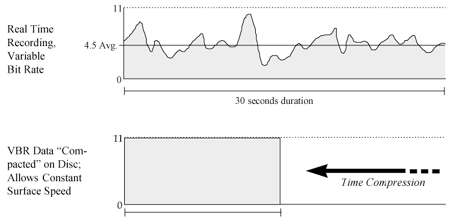
Upon playback, a video player accomplishes the necessary bit rate variation with a buffering technique as illustrated below:
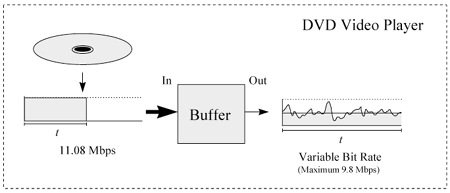
As these illustrations show, all information, video or otherwise, is written at the full 11.08 Mbps data rate, with playback equipment providing any necessary time base adjustments.
DVD-R Applications
DVD-R's relatively low cost per megabyte, coupled with its physical storage efficiency and the portability of its recording equipment makes the medium applicable to a large variety of uses in virtually all industries.
There are three fundamental applications anticipated for DVD-R:
- Testing and development
- Distribution
- Storage and archival
Testing and Development
Many DVD applications utilize replicated read-only discs that are mass-produced and distributed to a large number of users. Preparation of the content that will be published can be a complex and time consuming process that must be completed accurately to avoid errors or functional defects. Compared to the cost of the mastering and set-up efforts required to replicate only one disc, DVD-R provides a far more cost effective method of testing content prior to mass production. A single low cost disc can be quickly written and tested in a representative destination device (video player or ROM drive).
In fact, multiple test discs may be required throughout the development process, as published titles are often the collaborative effort of many people. As a result, DVD-R media can make a significant contribution to reducing the cost of DVD publishing.
The relatively recent achievement of 4.7 GB capacity on DVD-R media has helped to realize parity with DVD-5 replicated discs. This allows both qualitative and functional testing of titles that will utilize the full capacity of mass-produced media – a substantial issue in the DVD video authoring world.
Distribution
DVD-R’s low-cost media and relatively portable recording equipment can aid small-scale distribution of DVD content. As in the testing example above, mastering and replication expenses can be prohibitive when only a single disc or very small quantity is required. DVD-R allows discs to be recorded at the desktop level, which can result in very quick turnaround and significantly lower cost.
Some users may not be comfortable with sending sensitive data files or other work in progress to an outside facility for replication, so the ability to maintain continuous in-house control of this information can be crucial. This is particularly true with classified data maintained by Government agencies. Complete confidentiality is afforded by DVD-R because it can easily be maintained as a completely in-house process.
Storage and Archival
DVD-R media provides archival lifetimes that are equal to or better than CD-R; Pioneer media is rated at greater than 100 years. For this reason, the format is suitable for long-term archival of any information that can be stored digitally. This includes image data, film and video archives, or any other media that need to be retrieved more easily by users. In fact, DVD-R’s much larger capacity makes it especially suitable for large image files that do not fit onto a single CD-R volume, thus creating new opportunities for inexpensive storage of these assets. High-resolution satellite images are an example of very large files in excess of one GB each.
Since DVD discs are dimensionally identical to the CD family of discs, they have the advantage of being compatible with existing CD-based jukebox and changer mechanisms. This allows automated retrieval of recorded DVD-R volumes in networked environments, with a six to seven-fold increase in storage density as compared with CD-R technology.
As an example of how DVD-R can reduce overall archival system costs, a 100-disc DVD-ROM jukebox can contain a total of 470 gigabytes, or nearly a half-terabyte of data. If 50 kilobyte image files are written on every disc, a total of 10 million images can be stored and retrieved in an single, compact device. Using CD-R, seven of the same jukebox mechanisms would be required to maintain the same disc-to-drive ratio, which significantly adds to the system cost.
Conclusion
In essence, DVD-R dics can be thought of as enormous "bit buckets". Any kind of digital data can be stored on them, such as high quality video databases, motion pictures, document images, audio recordings, multimedia titles, and so on. The format’s high capacity and data transfer rate has the potential to expand existing CD-R applications in two dimensions: faster information flow (i.e., higher quality video), as well as significantly more data on each volume. DVD Recordable provides users with a powerful new tool that has applications in nearly every industry. Pioneer believes that DVD-R is the next logical step forward from the very successful CD-R format in applications that benefit from write-once security but inevitably require more capacity. As DVD technology takes its place as the eventual replacement for the ubiquitous CD, DVD-R will become an indispensable medium that can be counted upon to store and deliver digital information reliably and inexpensively.
Home | Audio | DIY | Guitar | iPods | Music | Links | Site Map | Contact